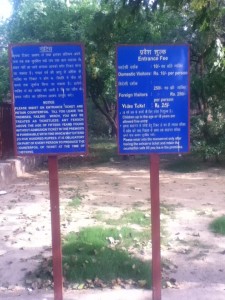By TIM ROSENKRANZ, 7/19/2014. The first time, I encountered the concept of a “tourist price” in India was by coincidence. My wife and I went to buy a leather bag in one of the many leather stores in Mumbai. My wife is from Mumbai, which proved to be significant. After a short look on the tag, the vendor gave us a much lower price. “That price is just for tourists.” We probably still overpaid in the end, but the notion that tourists should pay more in India turned out to be a pervasive concept, even though it is enacted in quite different ways.
The next time I ran into the “tourist price” was in New Delhi, as we visited Humayun’s Tomb. At the entrance, it stated clearly a low Indian entry-fee and a significantly higher tourist fare (see photo). The same applies to the Taj Mahal in Agra and actually every official, public, state-run tourist site in India.
One can argue about the (non)sense of having a local and a tourist fee for public sites. I actually think it is only fair to enable cheap (or better free) access to cultural and heritage sites for the local residents, while the tourists end up paying for the upkeep of these sites. This system acknowledges on the one hand the resident’s ownership over these sites, and on the other hand the sites reflects the commercial capacity in terms of tourism. The dual pricing therefore expresses the dual existence of tourist sites.
The problem with this dual pricing is that it seemingly applies to everything in India and is by far not as lucid and clear as in the case of the entrance fees to tourist sites. A soft-drink on the street, a taxi ride in Delhi, a bag in the market or a souvenir in the bazaar – everything has two different prices, and mostly this difference is not made explicit. One might say this is just the way things are done in India, as it is a bargaining economy at large. Every price is up for debate. The idea that one product has one price does not exist, and even locals constantly haggle and get hustled. But having flexible pricing is not the same as a dual pricing system. Tourists will (almost) never be able to get the price the locals pay, as they just don’t have the knowledge of what that price should be.
For the Indian travel industry, this pervasive dual pricing presents a significant issue. In my interviews with local travel agents and tour operators this lack of price clarity came up almost immediately, as my respondents claimed it creates a permanent uncertainty. To put it more clearly: Tourists supposedly feel constantly cheated as they experience India. Through their associations, the travel industry lobbies on the federal and state level for a stronger control of prices and commercial activities at least around the main tourist sites and cities.
In short: The Indian travel industry wants the government to eliminate the dual pricing system for tourists, at least in its unofficial capacity. The state should enforce a “fairer” treatment of tourists. This is quite ironic, as the state runs an official dual pricing scheme, which in part legitimates the actions of private individuals to copy this practice

